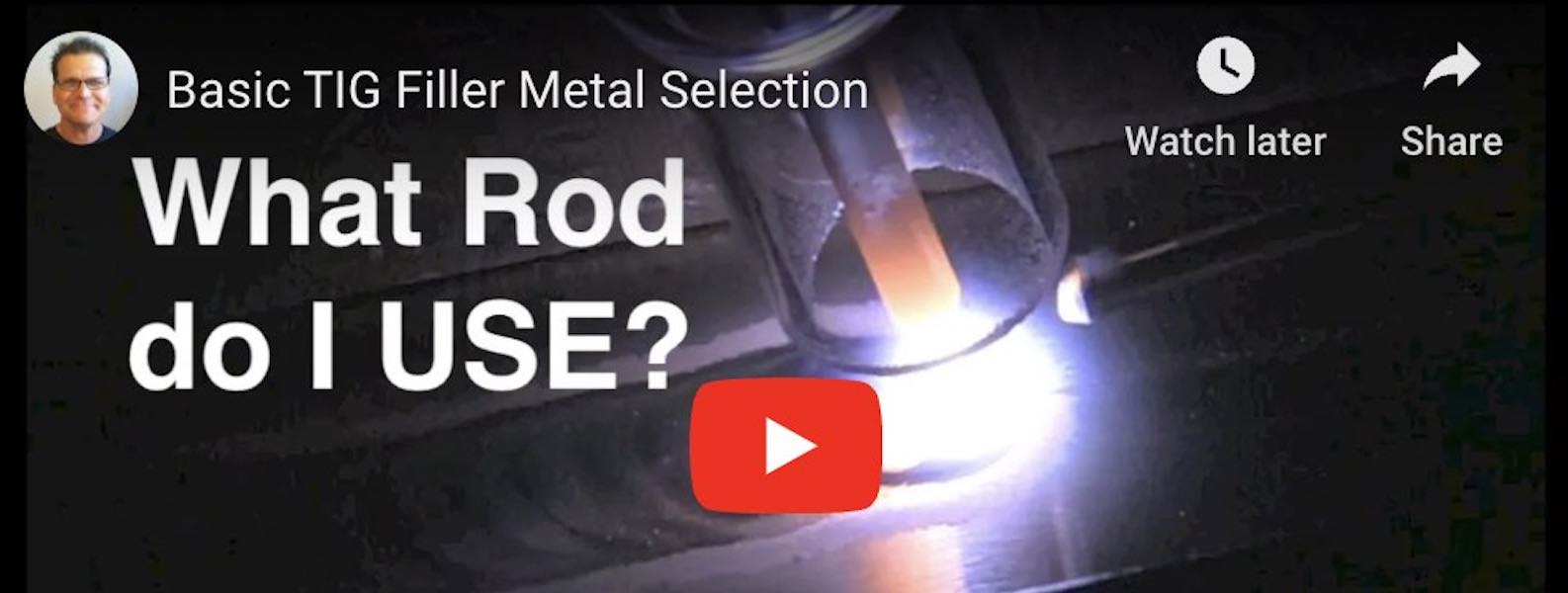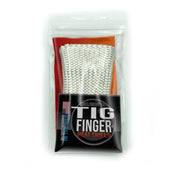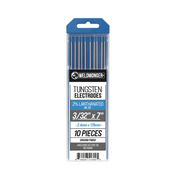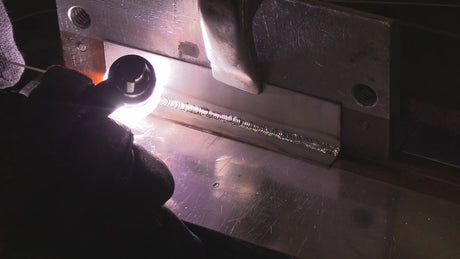Here are my recommendations for filler metals when starting out.
I have accumulated lots of different alloy filler metals over the years but here are the most common filler metals any welding shop needs to start with
- Er70s2 for all low to medium carbon steels and 4130 chromoly .045", 1/16", 3/32" (unless a procedure specifies a different filler)
- Er70s6 for full penetration welds on low to medium carbon steels and chromoly .045", 1/16", 3/32" (unless a procedure specifies a different filler)
- ER308L for 304L stainless sheet metal and tubing .030", .045", 1/16"
- ER309L for welding carbon to stainless or pretty much any steel to any steel 1/16"
- 4043 or 4943 aluminum for general purpose aluminum and aluminum castings 1/16", 3/32"
- 4047 for less porosity on cast aluminum... if you do a lot of castings 1/16", 3/32"
- 5356 for 5000 series aluminum or for 6061 when aluminum parts will be anodized ( see Esab filler metal chart ...link below) 1/16", 3/32"
- Silicon bronze for copper alloys and fixtures 1/16", 3/32"
- Aluminum bronze for cast iron repairs on AC 1/16", 3/32"
resources: Esab Filler metal chart
Alcotec Aluminum filler metal chart and guide
https://www.washingtonalloy.com/wp-content/uploads/2020/12/stainless-selector-guide.pdf
Lets talk about some of basics of filler metal for TIG welding.
first off,
I am not a welding engineer, or metallurgist.
but I am definitely a student of metallurgy and even worked in a metallurgical lab for over 5 years.
Basically I am a welder who likes to share practical info from what I have learned over the past 40 years.
to get the conversation started, lets talk Carbon steel, stainless, and aluminum, and a few dissimilar metal combinations.
First I want to talk about when you can’t select filler metal.
And what I mean by that is welding to some type of code or standard.
That could be a power piping code like b31.1, structural welding code like AWSD1.1,
if you are an employee you might be using a wps. (Welding procedure specification)
Or you might be complying with a repair in a manual like Pratt and Whitney or GE, or you could be following food service welding policies.
In those cases, you must use the filler metal specified. You can’t just pick one even if you think its a better choice.
With that out of the way, there are times when you alone will select the filler metal so here are a few tips.
First lets talk about carbon steel and also low alloy steels.
1010-1020 steels
Sheet steel, cold rolled steel, DOM tubing
A36
Mostly comes in hot rolled with mill scale coating
Most popular filler rods for all of the above are er70s2 and er70s6
I think that when full penetration welds are made, that er70s6 provides smoother penetration on back side.
that extra silicon in er70s6 seems to help combat oxides when the back side gets molten.
Don’t use coat hanger and don’t use gas welding rods like RG45.
Neither one contain the needed deoxidizers to prevent porosity.
Quick tips...
Twist up leftover remnants of er70s6 mig wire using a drill motor for filler rod when you are out of tig rod and only need small bit to finish a job on Saturday when welding stores are closed.
Low alloy steels
4130 chromoly, high strength steel like A572
4130 chromoly tubing is often welded with er70s2 filler metal.
this is true for motorsports as well as aviation.
But some 4130 components are heat treated after welding and those are usually welded with 4130 rod.
er70 rods wont respond well to heat treatment
Sometimes er80sd2 is used. It is a bit stronger, but often times in motorsports applications, the strength is mostly accomplished in the design with cluster joints and gussets.
Still, some prefer the way er80sd2 flows.
Er70s2 and even er70s6 tig rod is cheap.
You can get er70s-2 at your local welding supply or order it online from weldmonger.com , amazon, and plenty of other sites. Because it is so inexpensive, I would recommend getting some .045” , 1/16” and 3/32” .
1/16” is probably the smallest you will see at your local welding supply but .045” easy enough to get online.
And If you might ever be welding thin wall tubing, some .045” will help a lot.
Considerations for selecting a filler metal
Strength
strength of a filler metal is most often referred to as ultimate tensile strength and that is what the 70 in ER70s-2 filler wire indicates.
sometimes the strength of a weld joint is more dependent on design of the weld joint than on strength of the filler metal.
2 examples of this are
1. 4140 engine stand where the part was designed so that the weld itself was not really stressed much at all.
I used a ER70s-2 filler along with a 500f preheat on this 4140 part because maintaining a ductile and crack free weld free of brittle areas was more important that tensile strength of the weld metal.
2. 4130 cluster joints on aircraft fuselage as well as cluster joints found on off road vehicle chassis rely more on triangulation than pure weld strength.
often times ER70s-2 is used for welding 4130 chromoly for both of these situations.
er70s-2 is an undermatching filler metal to 4130 and will not respond to heat treatment much but it often a better choice that using 4130 filler metal when the part will not be heat treated to full strength or stress relieved after welding.
this is not to say that welds dont need to be strong….just strong enough… what you really need is a weld that will hold up to service conditions. A weld that is strong enough and that has adequate toughness and ductility.
Hardness
either as welded…or after heat treatment
for injection mold repairs or hardfacing, hardness is one of the most important considerations.
in the case of mold repair choosing a matching filler metal with matching hardness is often done but not always. In my experience there are usually parts of a mold that get damaged by workers whose job it is to remove the part from the mold.
Sometiemes workers use pry bars or screwdrivers to pry apart a 2 part mold and damage some areas.
I have repaired more than a few of these type areas and used a softer filler metal like inconel 82 that machines easily.
for hardfacing, the rod is often a completely different chemistry than base metal but is compatible and offers much greater hardness and or wear resistance than the base metal.
corrosion resistance
The stainless steel manifold I welded for my friend JD Brewer was made from 304L stainless and 304L is the most widely used stainless steel.
304L stainless is typically welded with ER308L which is a pretty close match and offers pretty much the same exact corrosion resistance as the 304L base metal.
But what if this part were made from 316L…or 321 stainless?
316L is much more corrosion resistant than 304L in certain environments and would need to be welded with 316L filler metal to retain those same anti corrosive properties.
321 is what is known as a stabilized stainless steel and is often specified for high temp applications. 321 should be welded with either 321 or 347 filler metal to retain its resistance to carbide precipitation that occurs at high temps.
Color match and heat treatment.
Color match sometimes applies to appearance as welded for example, copper welded with silicon bronze…but sometimes the main concern is due to a surface treatment after welding.
example: 6061 aluminum is often welded with 4043 filler rod but if post weld anodizing is called for, the weld will turn black if 4043 filler is used.
5356 filler rod is the better choice if the part is to be anodized after welding.
a filler metal chart for aluminum can be found here.
some steel parts are plated or coated after welding too.
often times tooling is made from 4140 and is black oxide coated after welding
309 filler rod can be used for 4140 in some cases but it will not blacken.
so if color match after blackening is a customer requirement, then 309 would not be the best choice.
also, if a part is to be post weld heat treated for strength, a filler metal that responds to heat treatment should be used. neither 5356 or 4043 will appreciably strengthen during heat treatment. But there are filler metals that will respond to heat treat like 4643 or even the newer 4943.
One video I posted showed welding a hydraulic cylinder using 4643 filler metal and the reason the customer specified 4643 filler was for heat treatment after welding so that the weld would be strong enough
Performance in service
I mentioned that 321 stainless is often specified when corrosion resistance is required at elevated temperatures as in automotive exhaust systems.
Another example of this type scenario is aerospace hot section parts.
when I worked in airline engine maintenance, we repaired a lot of parts made of hastelloy X.
And we would sometimes see Hast X parts that had been welded with the wrong filler rod…usually hastelloy W.
The hastelloy W weld would be pitted severely because hastelloy W is not designed to operate in as high a temperature environment as hastelloy X.
5356 filler metal is stronger than 4043 but at elevated temperatures the silicon and magnesium dont play well together and can set up crack sensitive areas.
So while the 5356 filler might be a better choice if the part welded will only experience mild temperatures, 4043 is a better choice if higher temperatures are experienced.
overall weldability.
examples…. sometimes there are important factors not listed like tendency for porosity, how a filler metal flows, availability at local welding supply, and cost.
for aluminum castings like oil pans, crank cases, boat props, engine parts, an a.356 or a357 filler rod might be the best match for strength and corrosion resistance. But it might not be readily available and might cost more than you want to pay for a repair on a friends motorcycle crankcase.
4043 will be readily available and will be a close match.
but 4047 might work better on an oil soaked casting due to its lower melting point and tendency for less porosity.
While er70s-2 filler might be just fine for tig welding 4130 as well as DOM tubing, you might find that er80sD-2 filler flows better and looks better at only slightly more cost.
Odd jobs and dissimilar metals
There are a few rods that are great to have around for welding dissimilar metal combinations …
309L is designed for welding carbon steel to stainless steel.
It works great for a whole bunch of applications where you are not completely sure of the composition of what you are welding. (Remember if the application is critical where someone could get injured if the weld fails, knowing the base metal is a must)
312 stainless is probably even more versatile due to its higher chromium and nickel content. And if you have every heard of super missile weld filler rods, its pretty much just 312 stainless with a hooky name.
Both 309 and 312 can be used for welding tool steel, chrome vanadium steels, or any combination of stainless steel to pretty much any other steel.
It won’t necessarily make a weld as strong as either base material but it can get you by…thats why 312 stainless is referred to as an all purpose maintenance rod.
Inconel 625 and hastelloy W are also very good all purpose maintenance rods but are way more expensive.
Silicon bronze and aluminum bronze are also great rods for dissimilar metal combinations.
Both silicon bronze and aluminum bronze filler rods will join copper to steel, copper to brass or bronze, and pretty much any copper alloy to any other copper alloy.
Aluminum bronze is a bit stronger and I like aluminum bronze for certain cast iron repairs too. I use AC settings like I would on aluminum.







3 comments
Very informative as usually. I couldn’t find a link to the charts you mentioned.
great info about rod selection. you covered about 99.9% of what any welder will ever need to know about which rod to use for any application and why. very concise. very valuable. thanks! always enjoy your videos. I have almost 40 years experience as a union pipe fitter welder. I did stick, tig, and mig. oil refineries, chemical plants, power houses then pharmacutical, breweries, and chip houses. you do a great job with teaching and getting great arc shots.
High 13% si 4047 braze on al is impressively fluid & searching , while as also , fine al not heat treatable
Precipitation ageing al casts welds puts all amounts of constituents into solution from mix. From a beta to ideal alpha alloy
Al bronze freezes in 10degrees as poured in the blink of an eye is solidus !! Thanks jode